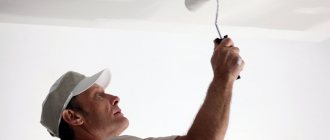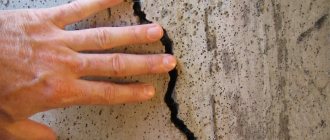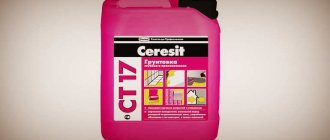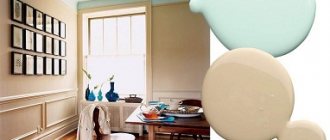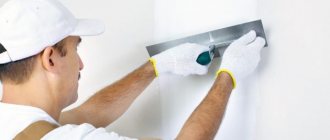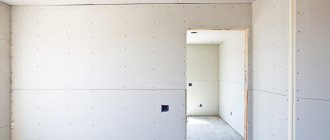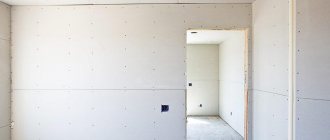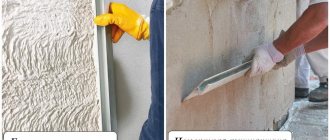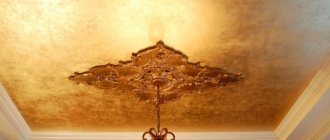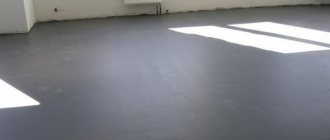Any building made of expanded clay concrete blocks needs plastering. This allows you to protect the walls from negative factors and extend their service life, and therefore the entire building as a whole. Finishing can be done in other ways, but this technique allows you to cope with the work at the lowest cost.
You can find many varieties of plaster on sale today; it can be made from cement and sand, gypsum and other components. Each of these compositions has its own advantages and disadvantages. For example, with a cement-sand mixture, the advantage is the aesthetics of the result, but gypsum plaster has a lighter mass and has more impressive thermal insulation properties. The latter allows you to achieve a good result in terms of the evenness of the wall, and the first forms the most durable layer.
Basic requirements for plaster on expanded clay concrete blocks
Before applying plaster to walls made of expanded clay concrete blocks, you first need to select it correctly. It must meet certain standards. So, the composition must cope well with moisture and also have plasticity. The layer should be durable and, when applied, adhere well to the base material. There are techniques for this, which involve applying cement laitance. But such preparation is not always required.
If we are talking about lightweight concrete, such as expanded clay concrete, then they are not so resistant to mechanical damage, in addition, the porous structure sometimes absorbs water well, which subsequently destroys the material. Blocks need high-quality protection from negative factors, which is why it is so important to choose the right plaster. It is also very important to lay expanded clay concrete blocks in a high-quality manner if, after completion of construction, you plan to finish them with plaster, because you may be faced with the need to apply the composition in a thick layer. And if you choose a heavy mixture based on cement and sand, it will put a very large load on the foundation of the house. But the foundation is not always built deep. Therefore, you may be faced with a dilemma about what you can decorate the walls with, but not overpay or spend too much effort on it.
Types of plaster
Surfaces made of expanded clay concrete blocks are plastered with cement-sand and gypsum mixtures. Plaster reduces the thermal conductivity of walls and provides the correct gradient of vapor permeability. Ease of use and adhesion strength to expanded clay concrete walls are higher with sand-cement plaster. However, the surface of masonry stones unevenly absorbs moisture from the mortar, which can lead to fragmented shrinkage and disruption of the aesthetics of the surface. Another danger is possible weak adhesion between the plaster and the wall surface.
Cement-sand
The plaster goes well with wall blocks due to the identical compositions. It is ideal for tightly closing pores, cracks and smoothing seams, which is important with constant changes in humidity and air temperature. This plaster can be easily painted to form the desired exterior façade or interior walls. Plastering creates additional pressure on the foundation, which should be taken into account.
Advantages
Cement-sand plastering is the simplest and most aesthetic finishing method. The composition of the mixture has high adhesion to the base of expanded clay blocks, which creates a durable coating. It is better to cover masonry in rooms with high internal humidity with this mixture. This coating saves the project budget.
Plaster
This material has a lower density and increased thermal insulation properties compared to a cement-sand mixture. This type of plaster does not adhere well to the base unless ingredients with concrete contact properties (or ready-made dry mixtures) are used.
Advantages
In terms of performance characteristics, plastering with a gypsum-based mixture is similar to a sand-cement composition. However, the material itself per unit area (with the same layer thickness) is lighter than the cement-sand mixture and somewhat warmer. The exterior of the finished surface can be perfectly smooth.
Types of plaster on expanded clay concrete blocks
In order to finish expanded clay concrete blocks from the outside or inside, you need to select plaster. It can be made on different bases, for example, you can find a silicone or acrylic mixture on sale. Silicate and mineral plaster copes well with the task. Each of these compositions has its own advantages and disadvantages.
If you choose mineral plaster, it may have a certain binder component, taking into account which the characteristics are determined. The cement-sand composition is quite inexpensive, provides the ability to form a layer that is resistant to moisture and mechanical damage, and also adheres well to the surface. If you want to decorate the walls with a lightweight material that is highly durable, you should choose gypsum plaster, which will also provide the expanded clay concrete blocks with excellent vapor permeability.
Gypsum compositions are also good because they are easy to apply, and after creating a layer, it will also insulate the walls.
Plaster for walls made of expanded clay concrete blocks can be acrylic. Among its main properties are not only excellent ductility and the ability to transmit steam, but also environmental friendliness, as well as long service life and high strength. The walls look very attractive after this finishing, they tolerate moisture and the effects of temperature changes well. If you want to plaster the walls with this composition, you should know that it also has some disadvantages, one of them being flammability and insufficient vapor permeability. But the first characteristic is perhaps not so important for external walls. But if you plan to finish indoor surfaces with acrylic plaster, you should think about whether you should choose some other material.
Wall finishing with mineral-based mixtures
All compositions are applied according to the same principle. The difference can only be in the thickness of the layer. Exterior decoration of a house made of expanded clay concrete blocks involves the formation of fewer layers than if you were working with aerated concrete. You can achieve an ideal result by applying about two layers. There is no need for reinforcing mesh; you will only need to decorate the joints. At the next stage, finishing is carried out, which involves leveling. Some experts make do with just one layer.
The mixture dries quite quickly, and almost no moisture is absorbed from the composition, just like the solution itself. It will dry on its own, and there will be no need to use a mesh, but this will not affect the strength in any way. The base will need to be well prepared, clearing it of dirt and dust. Oil stains should also be removed, as should debris. If a solution appears between the products, it will need to be knocked down. The surface is well inspected for cracks. If they are found, they should be repaired, like holes and chips.
After this, the base is left until complete polymerization. The plaster is applied to a primer, which is selected depending on the finishing solution. The cement is not expected to require priming. You can apply plain water to the blocks before plastering. But if you use gypsum plaster, you will definitely need a primer. You can use quartz mixture or concrete contact.
External application may involve reinforcement only if the layer thickness exceeds 1.5 cm. In this case, fiberglass is used, which is fixed with self-tapping screws. You will need two layers, and before the first you will need to install vertical beacons. The starting layer is thrown on using a trowel and is well developed according to the rule. The surface is left in this state for up to 6 hours until the composition is completely dry.
The beacons are then removed, and then the final layer is applied.
Acrylic plaster mixtures
Houses made of expanded clay concrete blocks need insulation. If you want to save money at this stage, while also making the walls more attractive and durable, you should choose acrylic plaster. With its help, you can form a durable coating that will last up to 15 years. The mixture is sold in finished form, it includes a dozen components, and acrylic resin serves as the base. It provides strength to the layer after hardening.
Acrylic plasters are good because they have an affordable price, are frost-resistant and provide the wall with vapor permeability. The layer is characterized by moisture resistance and elasticity. If you carry out not only external plastering, but also the formation of a heat-insulating facade, it is better to use polystyrene foam as insulation. This is explained by the fact that acrylic plaster does not have such impressive vapor permeability.
Silicate plasters
This plaster for expanded clay concrete blocks is applied externally using a special technology. It is sold in buckets and is completely ready for use. You can also purchase the product in the form of a dry mixture, with additional pigmentation. This powder is additionally diluted with water and mixed with a construction mixer. Intensive mixing should be avoided, as the solution may become saturated with air bubbles, which will make its application more difficult.
It is necessary to maintain the proportion of mixture and liquid for each serving. If you exclude this recommendation, then after drying the plaster will differ in color. When finished, the mixture is a paste-like composition, into which additional fractions can be included to form the texture. Plaster is applied to expanded clay walls in a fairly thin layer, and this can be done not only manually, but also with the help of equipment.
Silicone based plaster compounds
Facade silicone plaster can withstand difficult conditions. It is very elastic, and its composition contains pigments that are resistant to solar radiation. The material copes well with moisture and practically does not suffer from mechanical damage. The layer is durable and can retain its appearance for up to several decades. There are a lot of varieties of such facade plasters; you may prefer a mixture to create different effects, for example, a fur coat or a lamb. Natural stones like granite can also be added here, which allow you to achieve a unique appearance.
Types of plaster
Expanded clay concrete walls can be plastered with both cement-based and gypsum-based compounds.
Professional spray plastering of expanded clay concrete wall
Advantages of cement-sand plaster:
- the composition includes cement - a material that is present in the blocks themselves, which contributes to good adhesion of the plaster to the wall surface;
- enhances the strength of masonry;
- suitable for interior and exterior decoration;
- possibility of cooking with your own hands.
Advantages of gypsum plaster:
- is not inferior in strength to cement-sand plaster;
- creates a smoother surface;
- has better thermal insulation properties compared to cement-sand mortar.
Plastering with cement-sand mortar
It is better to plaster rooms with high humidity: kitchens, bathrooms, etc., as well as cladding the outside of the building with cement-sand mortar.
Cement-sand mortar
An expanded clay wall does not require a thick layer of plaster; it is necessary to level the surface, hide the seams of the masonry, and cement-sand plaster on the outside of the building improves the waterproof qualities of the wall, protects the masonry from temperature changes, and creates a pleasant decorative appearance of the building facade.
It is possible to plaster expanded clay with a cement-sand composition without the use of reinforcing fine mesh, since usually the layer of plaster is no more than 1 centimeter. If you have the means, it is better to use it to increase the strength of the coating; it is very easily attached to expanded clay using dowel nails with a wide head, but this is not necessary.
It is enough to plaster the expanded clay in 2 thin layers, followed by grouting the dried mortar.
Do not forget to clean the surface from dust, debris and protruding masonry mortar before starting work. The solution must be chipped with a chisel.
Unlike gas silicate blocks and foam blocks, expanded clay concrete blocks do not absorb much moisture from the solution, so they can be plastered immediately without first passing a primer over the surface. It is enough to moisten the wall with water while applying the cement-sand mortar.
Gypsum based plaster
Gypsum plaster has a number of its advantages, which is why builders use it as often as cement-sand mortar.
Gypsum plaster reduces the thermal conductivity of the building, it is much more flexible and easier to work with. The coating made from gypsum plaster is smoother; decorative finishing can be applied to it immediately; it is perfect for wallpaper and painting. Thanks to modern technologies, compounds are added to gypsum plaster that increase its strength, so heavy facing materials can be glued to gypsum in the same way as to cement-sand mortar. The main thing here is to use a gypsum mixture designed specifically for heavy materials.
When plastering expanded clay concrete blocks with a gypsum-based composition, it is imperative to pre-treat the wall surface with agents that improve adhesion between it and the blocks. Such compositions are called “concrete contact”.
For wet rooms, use special gypsum mixtures, marked accordingly on the packaging.
Technology of applying plaster composition to expanded clay concrete blocks
External and internal application of plaster composition to expanded clay concrete blocks can only be carried out if you have the appropriate experience. To begin with, the surface is prepared, which involves not only removing defects, but also applying a primer.
The most important stage is plastering. If necessary, the solution must be prepared and pigmented. If special equipment is available, mechanized plastering can be performed. With the help of such installations, the solution is mixed without the involvement of a person and quite quickly.
Preparing the wall surface
Expanded clay blocks must be prepared before applying facade plaster to the walls of the house. To do this, all dirt is removed from the blocks, as well as oil stains, as well as everything that can reduce grip. A positive quality is that the layer of plaster mortar will practically not be absorbed into expanded clay concrete blocks, which have low water absorption.
As a preparatory layer, you can combine water with cement to create a solution that is applied before the main layer of plaster. This is true if the finishing is carried out on the basis of cement and sand. Expanded clay concrete masonry turns out to be quite smooth, so a layer of the mixture is poured in such a way as to form no more than 1.5 cm. If the work was not carried out by professionals, then the laying may have some defects, then the consumption of plaster will increase.
Preparation of plaster mortar and its application
If the solution was purchased in dry form, it will need to be combined with water and color added if necessary. Mixing in this case is carried out using a drill, which is turned on at low speed. When the solution is purchased ready-made, it can be applied immediately. Laying should be done with a trowel, and leveling should be done using a rule. To make this possible, beacons are pre-installed. 6 hours after applying the first layer, rub it well, and then begin applying the finishing layer.
Nuances of the work
If the house is not new, then its external walls also need to be freed from old finishing, even if it seems suitable for plastering. Sealing of cracks and seams is carried out flush with the surface. You can also use a ready-made solution for this. Sometimes you buy putty intended for seams. After preparing the laitance for the first layer of primer, the composition must be applied to the surface with a brush. You need to move it horizontally, which will increase adhesion between the layers.
Then you can start filling the mesh. If it is not there, you can replace the layer with staples. An alternative is metal anchors with washers. When placing beacons, you need to make sure that their position is level. In this case, you need to use a level or plumb line. A distance of 1.5 m is left between these elements, which will allow you to conveniently work with the 2 m rule.
The beacons are fastened using cement mortar.
When preparing the mixture yourself, you need to carry out this work using a wide tray. If you don’t have a mixer, you can use a spatula to bring the mixture to the consistency of liquid puree.
The solution can be poured onto the base with a ladle, and smoothing is carried out from the bottom up. The rule is to move not only down, but also left and right. The final layer is applied using a trowel. You need to try to fill all the depressions with the mixture. As soon as this layer has set, you need to grout it with a float, which the master moves at a run or in a circle. Once the plaster has dried, it needs to be primed or painted. Sometimes the surface is covered with any finishing, it can be decorative putty.
Mechanized block plastering
If you decide to decorate your home outside or inside using special equipment, you will receive many advantages. Firstly, the composition can be mixed in a short time, without using buckets and mixers. Secondly, it’s much easier to do this, and you won’t waste any effort. Thirdly, application can be done in an even layer; the machine will do almost everything for you.
The solution adheres well to the surface, and the layer is more durable, because it is supplied under pressure. Less building materials are consumed and labor costs are reduced. If you decide to use the device, you should select a special dry mixture. By finishing the interior walls in this way, you will be able to use any finishing materials for subsequent interior finishing.
The main nuances when finishing expanded clay concrete walls
Let's digress a little from the topic and talk about the material itself. The block, as we have already discussed above, consists of concrete and expanded clay. It has good vapor permeability, low thermal conductivity, and is relatively lightweight. However, its surface is far from perfectly smooth - there may be various pores, cavities, and protrusions. At the same time, it perfectly absorbs water from the external environment (for example, during rain or groundwater). And its geometric dimensions, as a rule, are characterized by significant deviations - up to several centimeters. It goes without saying that a wall built using these blocks will not have a clean surface or evenness. Hence the requirement for the thickness of the layer that the plaster can work with.
Of course, you can use thin-layer mixtures, but, as practice shows, this will be a more labor-intensive, time-consuming and expensive process. In this case, you will need to apply several layers, and each one must gain a certain strength - and this takes time. In addition, you need to provide the embedded elements necessary to connect them, or use a special plaster mesh. Alternatively, the first layer can be made in the form of separate “cakes” applied with a trowel or plaster trowel, which is then well primed after hardening, and after this the surface is finally leveled. As you can see, the process is quite tedious.
Thermal insulation from the inside
Insulating the walls of a house from the inside is an extremely undesirable option. When installing insulation inside a building, the dew point moves from the walls into the room, and the “thermos effect” appears. Condensation may appear on the walls, finishing, for example, wallpaper, becomes wet and peels off, and mold and mildew appear on the walls. Repeated freezing cycles of blocks lead to their destruction - the manufacturer provides 50-220 such freezing-defrosting cycles. After reconstruction, the usable area of the premises will decrease by the thickness of the insulation and finishing.
The use of internal thermal insulation is justified in cases where:
- The construction and finishing of the facade have been completed;
- the house is rarely used, the heating is turned off when the owners are away. When heating appliances are connected, the room warms up quickly, since the brick walls do not warm up. Internal insulation is the best option for cottages and guest houses;
- It is impossible to insulate external walls - for example, a dwelling in a building made of blocks is located in an apartment building.
Other advantages of this method are:
- possibility of carrying out work at any time of the year;
- there is no need to install scaffolding for working at height.
Materials
Materials with low moisture absorption rates are chosen as internal insulation. For example, mineral wool slabs are not suitable.
When choosing a technology, it is necessary to provide gaps between the insulation and the finishing. For example, it is advisable to install plasterboard or MDF panels on a frame made of galvanized profile.
It is recommended to use polystyrene foam or extruded polystyrene, rolled polyethylene-based materials, or foil-foil-foamed polyethylene as insulation.
Foam insulation indoors
The properties of polystyrene foam and penoplex are described above.
Foil polyethylene weighs up to 60 kg/m3, while the thermal conductivity is comparable to foam plastic, about 0.03 W/(m*K). The advantage lies in its ability to not absorb moisture and ease of installation on your own. The properties are slightly worse without a layer of foil.
Installation of thermal insulation from the inside
Any craftsman who knows how to use power tools can make thermal insulation of the inner surface of the walls.
- Foil insulation is laid on the surface of the wall, secured with dowels. It is important that the caps and dowels and nails are wide - like a “mushroom”.
Insulation with foil material
Important! Installation of foam plastic is carried out after installing the frame for finishing.
- A galvanized profile sheathing is attached to the wall for finishing with plasterboard or various siding modifications. Horizontal distances and vertical distances between lags are selected based on the finishing material. For drywall - according to the size of the sheets, for siding, plastic or MDF panels, no more than 50-60 cm between horizontal profiles. The foam sheets must fit between the profiles “in tension.”
- When installing the sheathing, provide a gap of 1-2 cm to the insulation after installing the finishing material.
- Install drywall or siding.
- Finishing is completed by plastering the surface. If you used drywall, or glue the corners onto MDF panels.
Important! When using rolled materials, it is necessary to overlap the junction of the outer walls with the ceiling and internal partitions.
Interior finishing (plastering) of walls made of expanded clay blocks.
After the construction of the frame of a house made of expanded clay concrete blocks is completed, the question arises, what do we use to plaster the expanded clay concrete blocks? To do this, you need to figure out in which rooms and why plastering of expanded clay concrete blocks is needed.
The inner surface of the blocks, as a rule, has good adhesion and most plaster mixtures fit well on them. However, if the room being used has high humidity, then it is better to treat the walls with a special primer for concrete surfaces. As a rule, cement-sand mortars for plaster are used in such rooms.
If this is an ordinary room, then you can use gypsum plaster without additional primer. The exception is very smooth or dusty surfaces. The average thickness of cement-sand plaster is 15-25 mm, and the thickness of gypsum plaster is 5-15 mm. Therefore, if the walls are fairly smooth, using gypsum plaster can be cheaper, despite the higher price per bag.
Photo. Marking walls for plaster using a laser level.
